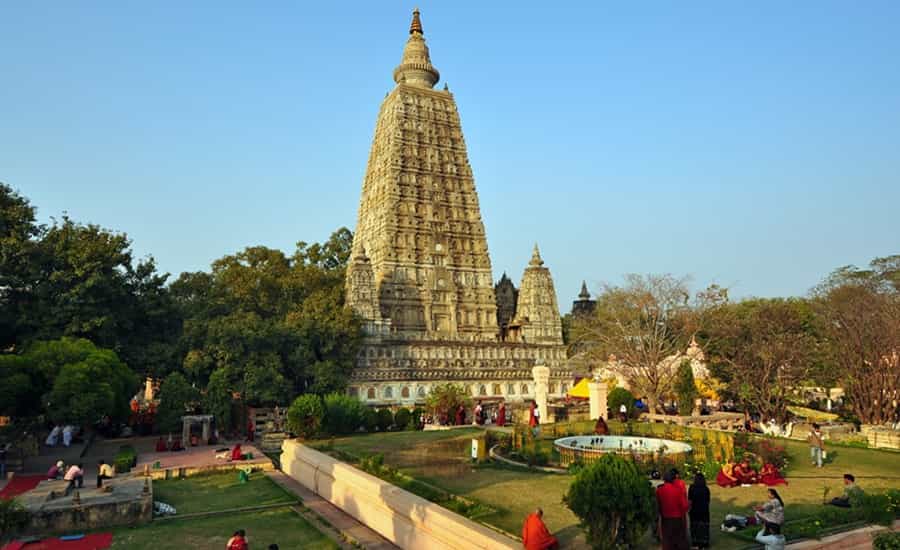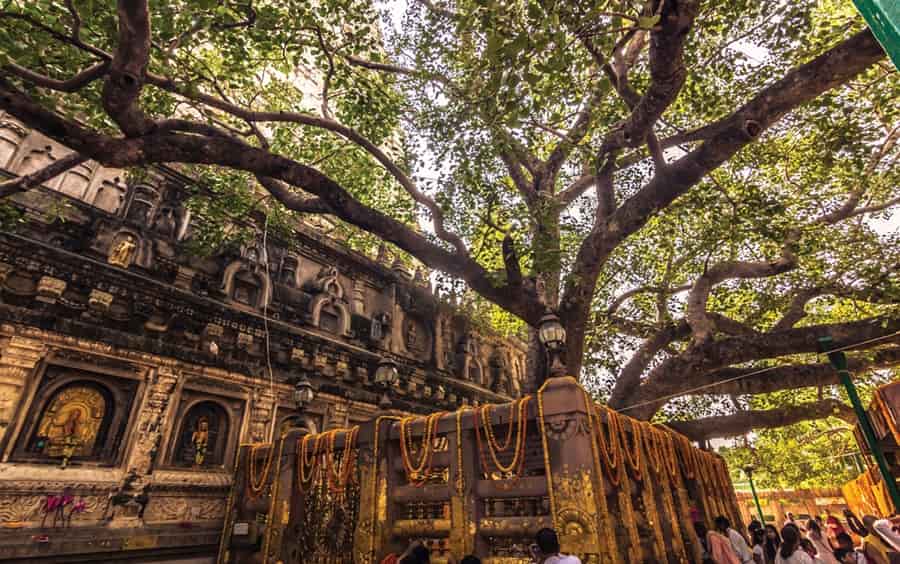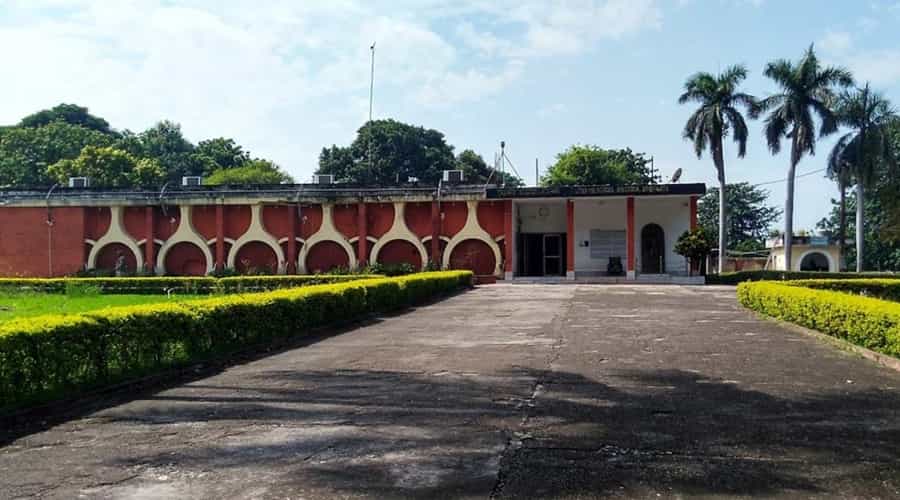Last Updated on 06/03/2024
The Mahabodhi Temple stands as an iconic testament to the spiritual journey of Siddhartha Gautama, who attained enlightenment under the Bodhi Tree nearly 2,500 years ago. Situated in Bodh Gaya, Bihar, India, this sacred site draws millions of pilgrims and tourists from around the globe, seeking solace, enlightenment, and understanding. With its rich history, architectural splendor, and profound significance in Buddhism, the Mahabodhi Temple remains a timeless symbol of tranquility and enlightenment.

Location
Nestled in the tranquil town of Bodh Gaya, Bihar, Mahabodhi Temple holds court over the sacred grounds where Gautama Buddha attained enlightenment. Situated on the banks of the Niranjana River, this hallowed site is approximately 12 kilometers from the city of Gaya and around 100 kilometers from the state capital, Patna.
History
Mahabodhi Temple’s storied past traces back over two millennia, to the reign of Emperor Ashoka in the 3rd century BCE. Driven by his profound conversion to Buddhism, Ashoka embarked on a mission to disseminate the Buddha’s teachings across his empire. His pilgrimage to Bodh Gaya culminated in the construction of a stupa marking the spot of Buddha’s enlightenment.
Over successive centuries, Bodh Gaya flourished as a center of Buddhist pilgrimage and learning, attracting devotees and scholars from far and wide. The present-day Mahabodhi Temple complex evolved through multiple phases of construction and renovation, with contributions from various ruling dynasties, including the Mauryas, Guptas, and Palas.
Despite enduring periods of decline and desecration, Mahabodhi Temple’s resilience and spiritual significance endured, culminating in its designation as a UNESCO World Heritage Site in 2002. Today, it stands as a beacon of Buddhist faith and a testament to the enduring legacy of the Enlightened One.
The Buddha
Gautama Buddha, the historical figure at the heart of Buddhism, plays a central role in the narrative of Mahabodhi Temple. Born as Siddhartha Gautama in the 6th century BCE, he renounced his princely life in pursuit of spiritual truth. After years of ascetic practice and meditation, he achieved enlightenment while seated under the Bodhi tree in Bodh Gaya. Renamed the Buddha, or the Enlightened One, he dedicated his life to sharing his insights into the nature of suffering and the path to liberation.
Mahabodhi Tree

At the heart of Mahabodhi Temple complex stands the revered Bodhi tree, believed to be a direct descendant of the original tree under which the Buddha attained enlightenment. This sacred fig tree, known botanically as Ficus religiosa, serves as a living symbol of awakening and spiritual renewal for millions of Buddhists worldwide. Pilgrims often circumambulate the tree, offering prayers and seeking blessings for their spiritual journey.
Architectural Style
Mahabodhi Temple showcases a distinctive blend of architectural styles spanning multiple epochs. The main temple structure, with its soaring pyramidal tower and ornate carvings, reflects the Gupta period’s artistic zenith. Intricate reliefs depict scenes from the life of the Buddha, while decorative motifs symbolize Buddhist cosmology and iconography.
Surrounding the temple, a series of ancient stone railings, dating back to the Mauryan and Sunga periods, enclose the sacred precincts. These intricately carved railings feature motifs of lotus flowers, celestial beings, and mythological creatures, offering glimpses into the artistic and religious sensibilities of ancient India.
Inside The Mahabodhi Temple Complex
Stepping into the sanctum sanctorum of Mahabodhi Temple complex, visitors are enveloped in an aura of tranquility and reverence. The main temple chamber houses a gilded statue of the Buddha in the “touching the earth” mudra, symbolizing his moment of enlightenment. Devotees offer floral garlands, incense, and lit candles as expressions of devotion and homage.
Adjacent to the main shrine, smaller chapels and pavilions host relics, relics, and artifacts associated with Buddha’s life and teachings. The ambiance resonates with the melodious chants of Buddhist monks and the fragrance of burning sandalwood, creating a serene atmosphere conducive to meditation and contemplation.
Timings & Entry Fee
Timings
- Open daily from sunrise to sunset.
- Specific timings for rituals and prayer ceremonies may vary.
Entry Fee
- There is no entry fee to visit the temple complex.
- However, nominal charges may apply for:
- Camera usage: INR 100
- Video camera usage: INR 300
- Meditation park entrance: Minimal fee (if applicable)
Other Considerations
- Electronic devices and mobile phones are not allowed inside the temple complex.
- Visitors can deposit their belongings at the baggage counter located at the entrance.
- Respectful attire and behavior are expected while visiting the temple, including removing shoes before entering the main shrine area.
Things to Do
- Attend daily prayer ceremonies and meditation sessions conducted by resident monks.
- Explore the temple’s architectural marvels and ancient stone inscriptions.
- Participate in ritual offerings and puja ceremonies at the main shrine.
- Visit the adjoining Bodhi tree and circumambulate its sacred precincts.
- Engage in spiritual discourse and teachings offered by resident scholars and monks.
Dress Code
Visitors to Mahabodhi Temple are expected to dress modestly and respectfully, covering their shoulders and legs. It is customary to remove shoes before entering the main temple and to refrain from wearing hats or sunglasses inside the shrine. Dressing in traditional Indian attire or Buddhist robes is welcomed as a mark of reverence for the sacred site.
Interesting Facts
- Mahabodhi Temple is one of the oldest surviving brick structures in India, dating back to the 3rd century BCE.
- The temple’s inscription-rich stone railings provide invaluable insights into ancient Indian languages and scripts, including Brahmi and Pali.
- The adjacent Bodhi tree is believed to be the oldest living human-planted tree in the world, with a documented history spanning over 2,500 years.
- Mahabodhi Temple’s architectural design served as a model for the construction of Buddhist temples across Asia, including those in Sri Lanka, Myanmar, and Thailand.
Festivals
- Buddha Purnima: Commemorates the birth, enlightenment, and death of Gautama Buddha.
- Asalha Puja: Marks the first sermon delivered by the Buddha after attaining enlightenment.
- Kathina Ceremony: Honors the monastic community and their contributions to the propagation of the Dharma.
- Magha Puja: Celebrates the gathering of 1,250 arahants (enlightened disciples) spontaneously convened by the Buddha.
- Uposatha Observance: Regular practice of Buddhist monastic community involving confession, purification, and reaffirmation of precepts.
- Vesak: Celebrated on the full moon day of the ancient lunar month of Vesakha, it marks the birth, enlightenment, and passing away of the Buddha.
- Anapanasati Day: Observance focusing on mindfulness of breathing meditation.
- Vassa: The three-month monastic retreat period observed during the rainy season, fostering intensive meditation and study among monks.
- Abhidhamma Day: Commemorates the Buddha’s descent from the celestial realm after teaching Abhidhamma to his mother, Queen Maya.
- Sangha Day: Honors the monastic community and their role in preserving and propagating the teachings of the Buddha.
- Dhamma Day: Celebrates the Buddha’s first sermon, known as the Dhammacakkappavattana Sutta, delivered to the five ascetics at Deer Park in Sarnath.
- Anapanasati Day: Observance focusing on mindfulness of breathing meditation.
- Pavarana Day: Marks the conclusion of the Vassa retreat period, during which monks seek forgiveness for any offenses committed.
Other Attractions Near the Temple
Here are some attractions near Mahabodhi Temple presented in bullet points:

- Bodhi Tree: The sacred fig tree under which Gautama Buddha attained enlightenment.
- Bodhgaya Archaeological Museum: Houses a rich collection of Buddhist artifacts, sculptures, and relics.
- Great Buddha Statue: A towering statue of Buddha, symbolizing peace and enlightenment.
- Sujata Kuti: Commemorates the generosity of Sujata, who offered rice milk to the Buddha before his enlightenment.
- Thai Monastery: A beautiful monastery showcasing traditional Thai architecture and religious art.
- Muchalinda Lake: Believed to be the spot where the snake king Muchalinda protected the Buddha during a storm.
- Rajayatna Tree: The site where the Buddha spent the seventh week after attaining enlightenment.
- Dungeshwari Hills: Scenic hilltop retreat with caves and temples associated with Buddha’s meditation practices.
- Mahakala Caves: Also known as Dungeshwari Hills, these caves house ancient shrines and sculptures.
- Vishnupad Temple: Dedicated to Lord Vishnu, this temple features a footprint believed to belong to Lord Vishnu.
- Chinese Temple: A serene temple built by Chinese monks, reflecting traditional Chinese architectural style.
- Tibetan Monastery: Offers insights into Tibetan Buddhist culture and traditions, with colorful murals and prayer halls.
- Archaeological Sites: Explore ancient ruins and remnants of Buddhist monasteries scattered across Bodh Gaya.
The Best Time to Visit
While Mahabodhi Temple welcomes visitors year-round, the optimal time to experience its spiritual ambiance is during the cooler months from October to March. This period coincides with several Buddhist festivals and commemorations, including Buddha Purnima, when the temple is adorned with colorful decorations and illuminated with festive lights.
How to Reach
By Air
- The nearest airport is Gaya Airport, located approximately 17 kilometers away from Bodh Gaya.
- Gaya Airport is well-connected to major cities like Kolkata.
- Alternatively, travelers can fly to Patna Airport, which is around 135 kilometers from Bodh Gaya.
By Road
- Bodh Gaya is accessible by road from various cities in Bihar and neighboring states.
- Bihar State Tourism Corporation operates regular bus services to Bodh Gaya from different cities.
- Both standard and deluxe buses are available for travelers’ convenience.
- Visitors can also opt for self-driving or hire taxis to reach Bodh Gaya.
By Train
- Gaya Junction is the nearest railway station to Bodh Gaya, located approximately 13 kilometers away.
- Gaya Junction is well-connected to major cities across India, including Delhi, Kolkata, and Mumbai.
- After arriving at Gaya Junction, travelers can hire taxis or autos for a 30-minute drive to Mahabodhi Temple.
Local Transportation
- Upon reaching Bodh Gaya, travelers can explore the town and its surrounding attractions on foot, bicycle, or hired vehicles.
- Auto-rickshaws and cycle-rickshaws are readily available for short-distance travel within Bodh Gaya.
- Many hotels and guesthouses offer transportation services for their guests’ convenience.
How to Plan a Trip to Mahabodhi Temple
- Research and gather information about Mahabodhi Temple’s historical significance, architectural features, and visitor guidelines.
- Determine the best time to visit based on weather conditions, festival schedules, and personal preferences.
- Arrange transportation and accommodation in advance, considering options such as flights, trains, buses, and guesthouses in Bodh Gaya.
- Prepare necessary travel documents and permits, especially if traveling from abroad or visiting during peak tourist seasons.
- Pack appropriate clothing and essentials for your trip, including comfortable footwear, sun protection, and items for religious observances.
- Create an itinerary that allows ample time to explore Mahabodhi Temple and nearby attractions, incorporating guided tours, meditation sessions, and cultural activities.
- Respect local customs and traditions, including the removal of shoes before entering sacred spaces and adherence to temple etiquette.
- Embrace the spiritual ambiance of Mahabodhi Temple with an open heart and mind, immersing yourself in its timeless wisdom and profound teachings.
Travel Tips
Research Beforehand
- Familiarize yourself with the temple’s history, significance, and visiting hours before your trip.
- Learn about any cultural customs or rituals observed at the temple to show respect and understanding during your visit.
Dress Appropriately
- Dress modestly and respectfully, covering your shoulders and knees.
- Remove your shoes before entering the main shrine area, as is customary in many religious sites in India.
Respect the Sacred Space
- Maintain silence and avoid loud conversations or disruptive behavior within the temple complex.
- Refrain from touching or climbing on any religious statues, artifacts, or structures.
Stay Hydrated
- Carry a water bottle with you, especially during hot weather, to stay hydrated while exploring the temple complex.
Protect Yourself from the Sun
- Wear sunscreen, sunglasses, and a hat to shield yourself from the sun’s rays, particularly during daytime visits.
Keep Valuables Secure
- Avoid carrying large amounts of cash or valuable items with you.
- Use a money belt or secure pouch to store important documents and belongings while exploring the temple.
Follow Photography Guidelines
- Respect any photography restrictions or guidelines within the temple complex.
- Pay any applicable fees for camera or video camera usage, if required.
Be Mindful of Cultural Sensitivities:
- Ask for permission before taking photographs of local residents or fellow visitors.
- Respect any signs or notices indicating areas where photography is prohibited.
FAQ”s
- Significance: Mahabodhi Temple is where Gautama Buddha attained enlightenment, making it a revered site for Buddhists.
- Visiting Hours & Fees: Open daily from sunrise to sunset, free entry with nominal charges for cameras.
- Photography: Visitors can generally take photographs, but some restrictions may apply in certain areas.
- Dress Code: Modest attire is required, covering shoulders and knees, and removing shoes before entering the main shrine.
- Nearby Attractions: Bodhi Tree, Archaeological Museum, Great Buddha Statue, Sujata Kuti, and Thai Monastery are nearby points of interest.
In conclusion, Mahabodhi Temple stands as a beacon of enlightenment and compassion, inviting pilgrims and visitors on a transformative journey of self-discovery and spiritual renewal. With its rich history, architectural splendor, and vibrant cultural heritage, it serves as a sacred sanctuary for seekers of truth and seekers of peace alike. Whether you come as a devotee, a scholar, or a curious traveler, a pilgrimage to Mahabodhi Temple is sure to leave an indelible impression on your soul, echoing the timeless teachings of the Buddha for generations to come.
Suggested Buddhist Tour in India:




 Call
Call WhatsApp
WhatsApp Enquiry
Enquiry